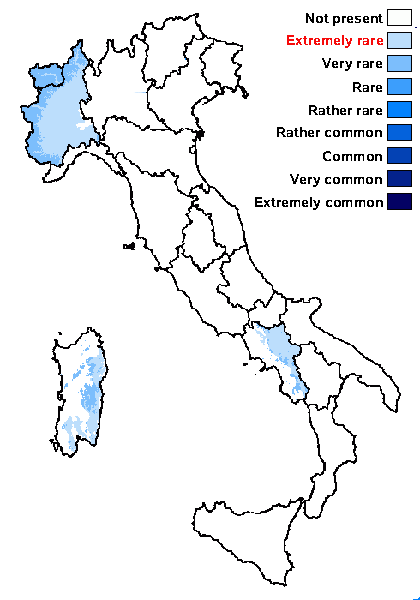Rhizocarpon tetrasporum Runemark
Opera Bot., 2: 86, 1956.
Synonyms:
Distribution: N - Piem (Morisi & Sereno 1995, Gheza & Nascimbene 2024), VA (Piervittori & Isocrono 1999). C - Sar. S - Camp (Aprile & al. 2002).
Description: Thallus crustose, episubstratic, greenish yellow, areolate, forming 3-6 cm wide patches delimited by a black prothallus, the areoles contiguous, 0.5-1(-1.2) mm wide, round to angular, flat to slightly convex, often verrucose. Cortex c. 35 µm thick; medulla white, I-. Apothecia lecideine, black, 0.6-1.2 mm across, round, with a flat to strongly convex disc and an initially thick, finally sometimes excluded proper margin. Proper exciple brownish in outer part, paler within, K+ red-brown; epithecium inspersed with black granules, K+ greenish; hymenium colourless in lower part, greenish in upper part, 100-150 µm high; paraphysoids strongly coherent, richly branched and anastomosing, the apical cells clavate. Asci (2-)4(-6)-spored, clavate, fissitunicate, with a well-developed tholus that is K/I- in lower part and K/I+ blue near the apex, lacking an ocular chamber, Rhizocarpon-type. Ascospores muriform, soon becoming dark green to brown, ellipsoid, 27-40 x 14-21 µm, halonate at least when young. Photobiont chlorococcoid. Spot tests: medulla K+ yellow, C-, KC-, P+ orange-red. Chemistry: cortex with rhizocarpic acid, medulla with stictic acid. Note: on siliceous rocks in the mountains. Closely related to Rh. viridiatrum and Rh. oportense, this species is worthy of further study.
Growth form: Crustose
Substrata: rocks
Photobiont: green algae other than Trentepohlia
Reproductive strategy: mainly sexual
Poorly known taxon in need of further study
Commonnes-rarity: (info)
Alpine belt: very rare
Subalpine belt: very rare
Oromediterranean belt: extremely rare
Montane belt: very rare
Submediterranean belt: extremely rare
Padanian area: absent
Humid submediterranean belt: absent
Humid mediterranean belt: absent
Dry mediterranean belt: absent

Predictive model
Growth form: Crustose
Substrata: rocks
Photobiont: green algae other than Trentepohlia
Reproductive strategy: mainly sexual
Poorly known taxon in need of further study
Commonnes-rarity: (info)
Alpine belt: very rare
Subalpine belt: very rare
Oromediterranean belt: extremely rare
Montane belt: very rare
Submediterranean belt: extremely rare
Padanian area: absent
Humid submediterranean belt: absent
Humid mediterranean belt: absent
Dry mediterranean belt: absent

Predictive model
 INDEX FUNGORUM
INDEX FUNGORUM
 GBIF
GBIF

